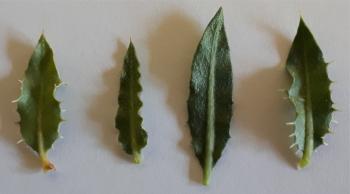Barleria rigida var. rigida
Barleria rigida var. rigida (Nees) C.B.Clarke
Family: Acanthaceae
Common names: scorpion thistle (Eng.); skerpioendissel (Afr.)
Introduction
Your first choice plant for the sunny dry areas in your garden.

Description
Description
A much-branched shrublet, up to 300 mm high. The stems arising from a woody rootstock. Stems are hairy, older stems white. The leaves are linear; leaf margins wavy, with or without spines and sometimes white. The apex (leaf tip) ends in a spine.

The flowers are usually solitary but sometimes in clusters of 1–5 flowers in alternate axils. The corolla is 2-lipped. The upper lip is 4-lobed and the lower lip 1-lobed. The flowers range from white, pink, blue to mauve. The flowers are subtended by calyx lobes.

The outer calyx lobes are ovate, membranaceus, reticulate, with or without the purplish tinge on the veins. The calyx lobe margins are serrated. The bracteoles (secondary bracts) are hardened, V-shaped in cross section, with scattered teeth on the margins, the apex ends in a sharp point.

The seed capsules are elliptic, tapering to a point.

There are 4 seeds per capsule. The ripe fruit capsule opens explosively when it is moistened.
Conservation Status
Status
According to the Red list of South African plants Barleria rigida is assessed as Least Concern (LC).
Distribution and habitat
Distribution description
Barleria rigida var. rigida is found growing mainly in the upper Karoo and also in parts of the Gariep Desert and Kalahari Karroid shrubland, in deep or shallow sandy soils and gravelly stony soils with dolerite and calcrete components. Barleria rigida var. rigida is frost tolerant, does not need a lot of water and prefers to grow in full sun.

Derivation of name and historical aspects
History
The genus Barleria consists of a large group of shrubs, shrublets and herbs and the genus is named after the Dominican monk and French botanist, Jacques Barrelier (1606–1673). The species name rigida means ‘stiff’ or ‘rigid’, referring to the woodiness of the plant.

Ecology
Ecology
Barleria rigida var. rigida is pollinated by insects and attracts various species of butterflies.
Uses
Use
No known cultural uses, however, it makes a striking plant in any garden.

Growing Barleria rigida var. rigida
Grow
This species is fast growing, grows well in full sun and does not need a lot of water. It flowers in the late summer, tolerates frost and droughts. Plants flower in abundance with less water, too much water stimulates vegetative growth and less flowers. It is the ideal plant to plant on the hot, western sides of your garden or to plant between your aloes on a rockery. There are no specific pests or diseases affecting Barleria rigida var. rigida.
Barleria rigida var. rigida grows easily from seed or cuttings. Harvest the seed from the ripe capsules. Sow the seed in summer, from December to March, in a container in a mix of 1 part washed river sand and 2 parts potting medium .Place the container in a shady spot and water once a week. Germination starts to take place in fourteen days. Transplant the seedlings when they are 10 cm tall.
Semi-hard plant material is the best for cuttings. Cut the cuttings in lengths of 10 cm. Plant the cuttings in a mixture of 1 part coarse river sand and 2 parts potting mix. Good drainage is essential. Treat the cuttings with a rooting hormone. Plant the cuttings 5 cm apart. Place the container in a shady spot and water twice a week. Plant the rooted cuttings in a good potting mixture. Expect a success rate of 60%.
References
- Balkwill, M.J. & Balkwill, K. 1998. A preliminary analysis of distribution patterns in a large, pantropical genus, Barleria L.(Acanthaceae). Journal of Biogeography. Vol 5: 95–110.
- Little, J. R. & Jones, C.E. 1980. A dictionary of botany. Van Nostrand Reinhold Compony, New York, Cincinnatti, Toronto, Melbourne.
- Raimondo, D. et al. 2009. Red list of South African plants. Strelitzia 25. SANBI (South African National Biodiversity Institute), Pretoria.
- Van Rooyen, Noel in collaboration with Hugo Bezuidenhout & Emmerentia De Kock. 2001. Flowering plants of the Kalahari dunes. Pp. 272 Thatchers Field Lynnwood 0081.
Credits
Willem Froneman
Lowveld National Botanical Garden
September 2018
Plant Attributes:
Plant Type: Shrub
SA Distribution: Northern Cape
Soil type: Sandy
Flowering season: Late Summer
PH: Acid, Neutral
Flower colour: Blue, White, Pink, Mauve/Lilac
Aspect: Full Sun
Gardening skill: Easy
Special Features:
Horticultural zones











Rate this article
Article well written and informative
Rate this plant
Is this an interesting plant?
Login to add your Comment
Back to topNot registered yet? Click here to register.